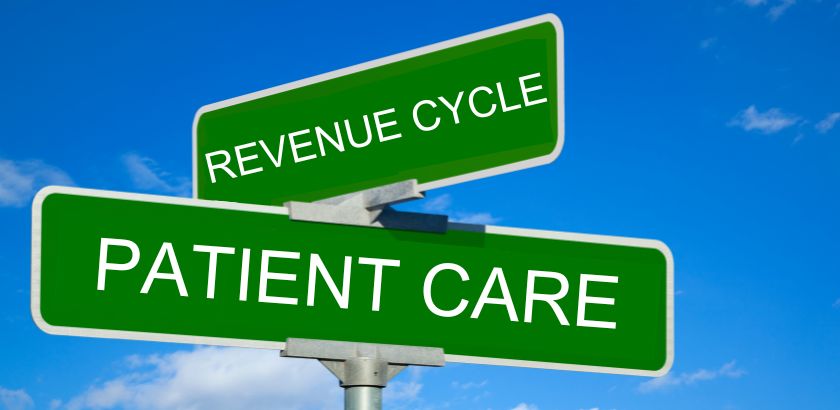Read Time:
5 Min
What You’ll Learn:
How to harness the power of data analytics to transform and unlock higher profits.
Read Time:
5 Min
What You’ll Learn:
How to harness the power of data analytics to transform and unlock higher profits.
In the dynamic landscape of the healthcare industry, the quest for efficiency and maximized revenue is a common goal. But how can healthcare organizations turn this challenge into an opportunity? The answer lies in understanding the role of data analytics in enhancing revenue cycle efficiency. Healthcare providers can unlock higher profits and ensure their financial well-being by harnessing the power of data.
Data analytics enables healthcare organizations to transform their administrative and clinical processes, optimizing their revenue cycle. From streamlining claim submissions to improving patient billing accuracy and proactively managing denials, the role of data analytics in enhancing revenue cycle efficiency plays a critical part in the revenue cycle management process. It’s high time healthcare organizations recognize the potential of this powerful tool and leverage it to enhance their revenue cycle management.
Data analytics plays a crucial role in enhancing revenue cycle management (RCM) in healthcare by streamlining claim submissions, ensuring precision in patient billing, and managing denials proactively to mitigate financial risk for healthcare organizations.
Predictive analytics and the digital transformation of RCM, including AI-driven insights and the automation of billing processes, are reshaping healthcare efficiency and strategic decision-making, potentially improving patient outcomes and financial performance.
Outsourcing RCM to specialized service providers allows healthcare organizations to leverage expertise in data analytics and regulatory compliance, potentially leading to cost savings, revenue stream enhancements, and increased patient satisfaction.

Modern healthcare revenue cycle management heavily relies on data analytics. Overseeing administrative and clinical processes related to claim submission, patient billing, and payment receipt, data analytics optimizes claim reimbursements and service revenue. This strategic approach safeguards the financial well-being of the healthcare organization, ensuring a smooth revenue cycle.
There are multiple benefits of using data in revenue cycle management. It not only streamlines the claim submission process but also ensures:
Accuracy in patient billing
Proactive denial management
Preemptive detection and resolution of potential claim denials
Reducing the administrative workload
Enabling more focus on patient care
Increasing patient service revenue
Data analytics empowers healthcare providers, including your healthcare provider, to achieve these benefits.

Submitting claims to insurance companies is a critical yet tedious task in the healthcare industry. However, with data analytics, the efficiency of this process can be significantly improved, even for a single insurance company.
Benefits of using data analytics for claims processing include:
Identifying patterns and potential errors
Speeding up reimbursements
Improving accuracy in claims submission
Reducing manual work and paperwork
Enhancing overall revenue cycle management
By leveraging data analytics, healthcare providers can streamline their claims processing and ultimately provide better care to their patients.
Streamlining the process of claim submission through data analytics can also help in:
Identifying errors that may cause delays in the revenue cycle management process
Collecting and processing data
Recognizing patterns
Using insights to identify the root causes of denials
By doing so, healthcare organizations can guarantee timely patient payments and enhance revenue cycle management.
Accurate patient billing is a cornerstone of efficient revenue cycle management. Data analytics aids in precise patient billing, reducing the possibility of disputes or non-payment, ensuring accurate billing and efficient administrative and clinical functions. By pinpointing coding errors and unusual billing patterns, data analytics aids in proactive detection and correction of inaccuracies, leading to:
More efficient interactions with health insurance companies
Improved financial performance
Increased patient satisfaction
Enhanced compliance with regulatory requirements
The role of precise patient billing extends beyond accuracy. It plays a pivotal role in enhancing revenue cycle management by:
Maximizing revenue generation
Identifying missed opportunities
Optimizing reimbursement rates
Ensuring accurate data insights
By streamlining the billing process and offering clear, transparent pricing, healthcare organizations can optimize patient collections, a critical factor in successfully collecting payments.
Denial management is one of the top issues healthcare providers face today. Analyzing denied claims data helps tackle issues before they escalate and harm revenue. Data analytics helps enable this process by systematically spotting and tackling denial patterns and root causes. This proactive approach is essential for sustaining the financial well-being of healthcare organizations.
Integrating data analytics in denial management also includes a crucial step of appealing rejected claims. By submitting additional documentation or information to contest the denial within the appropriate timeline, healthcare providers can guarantee payment from the payer. This approach is an effective strategy in managing denials and ensuring a smooth revenue cycle.

Healthcare organizations can optimize their financial health by using predictive analytics in their revenue cycle management process. Some benefits of using predictive analytics include:
Analyzing patient data to identify optimal treatment plans, medication regimens, and engagement strategies
Enhancing patient collection strategies
Improving the efficiency of resource allocation
By leveraging predictive analytics, healthcare organizations can make data-driven decisions that improve patient outcomes and financial performance.
The use of predictive analytics extends beyond patient collection strategies. It also offers valuable insights into future admission rates, enabling healthcare providers to anticipate demand and optimize resource allocation. Such foresight can lead to improved staff scheduling and more efficient use of resources, ultimately contributing to the financial stability of the healthcare organization.
In healthcare, patient collections are a critical factor that determines an organization’s financial success. Predictive analysis helps identify patients prone to late or non-payment by analyzing factors like demographics, past payment history, and customer behavior. This insight enables healthcare providers to devise effective strategies and facilitate a more tailored approach to managing patient accounts.
Data-driven patient collection strategies can:
Streamline the billing process
Enhance patient-provider relationships
Identify patients at higher risk of late or non-payment
Customize the approach to improve patient relationships and overall satisfaction
Successful healthcare organizations often attribute their success to efficient resource allocation. Offering insights into areas of over or underutilization, data analytics aids in optimizing operational efficiency. This includes streamlining processes, identifying staffing issues, and improving recruitment, hiring, training, and retention of healthcare workers.
Using data analytics in resource allocation also involves analyzing different kinds of data such as caregiver specialty and experience, department information, and various forms of analytics such as descriptive, predictive, and prescriptive. Data analytics can contribute to effective resource allocation in the healthcare sector by furnishing high-quality data for policy decisions and improving operational efficiency.

Despite its complexity, compliance is an essential aspect of the healthcare industry. Data analytics can help healthcare providers navigate this complexity by:
Enhancing coding accuracy
Guaranteeing patient data privacy and security
Verifying that claims accurately represent the care given
Ensuring precise data gathering, medical billing, and coding
Minimizing the chance of submitting erroneous details to insurance companies
Regular education programs for healthcare employees also play a central role in fostering proper coding techniques and comprehensive chart documentation, essential for upholding compliance. By preventing costly audits, fines, and legal challenges, data analytics can safeguard the financial health of healthcare organizations.
Coding accuracy is a critical element of efficient revenue cycle management. Data analytics plays a pivotal role in achieving advanced coding accuracy by reducing the likelihood of claim denials and enhancing overall revenue. By identifying and rectifying coding errors, data analytics can improve the dependability and usability of data, thereby ensuring a smooth revenue cycle.
Data analytics can enhance coding accuracy by identifying typical coding errors such as:
Poor quality or missing documentation
Inaccurate coding
Lack of patient eligibility verification
Sending claims to the wrong payer
By ensuring comprehensive, precise, and uniform documentation, advanced coding accuracy mitigates the risk of claim denials, facilitating timely and accurate claim submissions.
Data analytics plays a crucial role in healthcare by:
Optimizing revenue cycles
Ensuring the privacy and security of patient data
Identifying potential issues related to patient data
Preventing costly legal challenges
Safeguarding the organization’s reputation and financial health.
Prevalent privacy and security concerns in healthcare data management include:
The loss of unencrypted devices
Hacking
Unintentional disclosure of patient data
Misuse of organizational resources
By adhering to stringent data management practices, healthcare organizations can ensure the privacy and security of their patient data, thereby maintaining trust and compliance with regulatory standards.

Data analytics can enhance patient care and optimize revenue cycle management in healthcare organizations. Some ways in which data analytics can achieve this are:
Improving patient access and scheduling
Customizing services to patient demographics
Enhancing the patient experience
Improving the financial performance of healthcare organizations
Enhanced patient access and scheduling contribute to improved revenue cycle management by facilitating the financial clearance of patients for their scheduled services, automating scheduling and reminders, streamlining patient registration and check-in processes, and improving patient communication. By customizing services to patient demographics, healthcare organizations can improve patient satisfaction, bolster patient-provider relationships, and enhance the revenue cycle.
Patient access and scheduling are crucial components of the healthcare revenue cycle. Data analytics can enhance these aspects, ensuring that:
Patients receive timely care
Healthcare providers optimize their revenue
Staff scheduling trends are identified
Patient needs are predicted
Chronic diseases are managed
Scheduling and resource allocation become more efficient
The use of data analytics can also significantly reduce waiting periods for patients. By analyzing patient data to recognize patterns and bottlenecks within the healthcare system, healthcare organizations can guarantee more effective scheduling and a better patient experience.
Tailoring healthcare services to patient demographics is an effective strategy to improve patient satisfaction and outcomes. By analyzing demographic information, medical histories, and care patterns, healthcare providers can identify high-value patient segments and their specific needs, thereby providing personalized medical services.
Data analytics can assist healthcare organizations in segmenting their populations based on factors such as demographics, insurance status, and health status. By identifying unique population subsets and segmenting email lists based on demographic data, healthcare organizations can devise tailored outreach programs, thereby addressing specific patient needs and enhancing patient satisfaction.

The digital transformation of revenue cycle management is a notable trend in the healthcare industry. Some benefits of this transformation include:
The benefits of digital transformation include:
This transformation not only improves the revenue cycle but also contributes to the overall performance of the healthcare organization.
Automating billing processes is an important component of efficient revenue cycle management. Here are some benefits of automated billing:
Streamlining processes
Reducing time spent on repetitive tasks
Optimizing business operations
Enhancing patient satisfaction
Improving cash flow
Data analytics plays an important role in automating billing processes. By offering valuable insights into:
billing performance
payment trends
client satisfaction
financial performance
Data analytics can help healthcare organizations identify areas for enhancement, streamline billing workflows, and make informed decisions based on data.

AI-driven insights can significantly impact decision-making processes in revenue cycle management. Some benefits of using AI-driven analytics in revenue cycle management include:
Optimizing revenue cycle management
Enhancing accuracy
Reducing costs
Optimizing revenue collection
Leveraging large data sets to generate insights
By utilizing AI-driven analytics, you can enhance the efficiency of the revenue cycle.
Data analytics can aid in managing large data volumes in healthcare, streamlining data collection and sharing, and enhancing the processes of diagnosis and treatment. By providing high-quality data for policy decisions, AI-driven insights can contribute to effective decision-making and efficient revenue cycle management.
Analytics-driven revenue cycle management can greatly improve healthcare services by:
Enhancing efficiency
Reducing costs
Increasing profitability
Improving patient satisfaction
Enabling data-informed decisions
Analytics-driven RCM can optimize revenue collection and improve overall healthcare services.
The use of analytics in optimizing processes within revenue cycle management rcm can identify inefficiencies, optimize processes, reduce denials, and increase revenue. By leveraging data to track and optimize operations such as patient billing, claims management, and payment processing, analytics-driven RCM can lead to improved financial performance and patient satisfaction.
Numerous case studies of healthcare organizations demonstrate the success of analytics-driven RCM. These organizations have improved their financial performance, optimized their revenue cycle management processes, and enhanced patient satisfaction by leveraging data analytics.
From gaining real-time insights into RCM to accelerating A/R recovery and driving higher RCM efficiency through self-service visual analytics, these case studies showcase the potential of data analytics in transforming revenue cycle management. These success stories illustrate the potential of data analytics in enhancing the financial performance and overall efficiency of healthcare organizations.

Healthcare organizations can gain a strategic advantage by outsourcing revenue cycle management. Outsourcing RCM to specialists allows healthcare organizations to focus on patient care while benefiting from the expertise of RCM specialists.
Outsourcing revenue cycle management can lead to significant time and cost savings, as well as enhancements to revenue streams and patient satisfaction. By choosing the right outsourcing partner and adhering to best practices, healthcare organizations can realize the full potential of outsourcing RCM and optimize their revenue cycle management processes.
Data analytics plays a crucial role in transforming revenue cycle management in the healthcare industry. By streamlining processes, improving accuracy, and enabling proactive management, data analytics can enhance the revenue cycle, improve patient satisfaction, and ensure the financial health of healthcare organizations.
The potential of data analytics is vast, from enhancing patient access and scheduling to improving coding accuracy and ensuring privacy and security. By leveraging the power of data analytics, healthcare organizations can navigate the complex landscape of revenue cycle management, optimize their processes, and maximize their revenues.
How can big data analytics be used in the revenue cycle?
Big data analytics can be used in the revenue cycle to gain insights into patients’ payment behavior, helping identify those who consistently pay late or have a higher likelihood of non-payment. This can optimize revenue management for healthcare organizations.
How can analytics drive revenue growth?
Analytics can drive revenue growth by helping organizations understand their customers, identify new market opportunities, and streamline processes to maximize revenue generation. By analyzing customer behavior and purchase history, businesses can tailor their marketing efforts and sales strategies to increase sales and revenue.
How data analytics can improve financial performance and efficiency in hospitals?
Data analytics can improve financial performance and efficiency in hospitals by identifying at-risk patients for early intervention and guiding decision-making for workflow, staffing, and inventory management.
How data analysis contributes to safe high quality efficient delivery of healthcare?
Data analysis contributes to safe high quality efficient delivery of healthcare by identifying at-risk individuals and improving health outcomes while reducing costs through chronic disease management services. EHR data can be reviewed to provide better care for patients.
What is a revenue cycle service?
The revenue cycle service encompasses the process of overseeing patient care episodes from initial registration to payment completion, incorporating steps such as preregistration, charge capture, and insurance follow-up. This financial process is crucial for healthcare facilities and is often managed through specialized medical billing software.

Our Locations
320 N Cedar Bluff Road, SUITE 300 Knoxville TN, 37923
Aurora, CO
Fort Morgan, CO
Eatontown, NJ
Jefferson City, MO